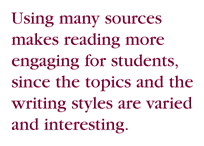How To: Toss the Text
Nine tips to help you get started teaching without textbooks.
This how-to article accompanies the feature "No Books, No Problem: Teaching Without a Text."
Given the demands of teaching without textbooks, using them may be the right way to go for some educators and subjects. But if you're committed to creating your own curriculum, start by slowly easing away from them -- unit by unit or lesson by lesson -- to develop a series of activities and lessons crafted specifically for your students. Here are a few tips.
1. Read widely.
Explore books addressed to many audiences: college level, general high school, and general interest. These will show you a variety of approaches and provide a ready supply of entry points for your students.
2. Plan and prioritize.
Decide what knowledge you want your students to have at the end of the year. Then identify gaps in the present curriculum and find ways to fill them. Instead of abandoning your textbook all at once, replace its worst lessons first. When you swap an ineffective activity with a more promising one, make sure unit assessments reflect the new content.

3. Borrow and adapt others' curriculum.
Old textbooks, other teachers, and searchable Web sites are great sources. Before trying a new activity, consider how to modify it to address your students' strengths and weaknesses.
4. Stay organized.
Archive and systemize your curriculum. Break your year-long plan into weeks and units. Every week should include an overview, individual lesson plans, the week's homework assignments, and student handouts. Every Sunday night, review and modify curriculum for the upcoming week.
Keep your curriculum on a computer where you can easily search for and modify any past lessons. Some teachers create a binder each year, building upon and modifying their previous work. Whatever organizational system you set up, make sure to use it conscientiously, even in the most hectic times, or you will duplicate work.
5. Keep your students organized.
Kids need extra support to succeed in classes that don't use textbooks. Without instructions and ongoing accountability, students will have incomplete notes and be unable to reference class material. Prescribe exactly how they should organize their binders and notebooks, and be clear about what class notes should be where. Assess the completeness and organization of their material regularly through notebook quizzes and random checks.
6. Customize homework.
Premade homework assignments save teachers time. But assignments reveal themselves as make-work if they don't flow into what you are doing in class, and students won't engage or try with them. One solution is to have kids write down what they think the main points of a lesson were or to create their own sample test questions and answers. Another option is to pull homework questions from textbooks but add recognizable names of students, teachers, or celebrities. This way, the students are more likely to relate to the customized questions.
7. Consider the barriers to doing without a textbook.
Costs: Working without a textbook means using more handouts. Make sure your copying budget is adequate.
Parents: Some parents may worry that, without a textbook, their kids aren't learning. Solution: Describe how the upcoming week's curriculum meets state standards, and offer the parents a textbook to use as an at-home reference (almost all classrooms have a few extra copies lying around).
Administrators: Be able to show you cover district and state standards, and point out the failures of textbooks. If administrators insist on a textbook, focus on supplementing the areas where it -- and your students -- are weakest.
8. Remember to teach textbook skills.
Textbooks help students practice reading skills they need to be well-informed and successful adults. Supply magazine articles or book excerpts that describe standard content in more-relevant or applied ways. (You might glean these written texts from articles, Web sites, general-interest books, and both standard and unconventional textbooks.) Using many sources makes reading more engaging for students, since the topics and the writing styles are varied and interesting.
9. Anticipate failure.
Not everything you pick will work. Plan a variety of activities for each lesson. That way, if one fails, you can cut it short, move the class onto something else, and brainstorm a new way to teach the material. When an activity is disappointing, decide whether you want to try it next year. If you do, make notes on how to improve it.
Monya Baker is a freelance writer and former science teacher.
How To: Resources
Get started on developing your own textbook-free science curriculum
Access ExcellenceThis site explores topics ranging from DNA research to sleep disorders for the benefit of health and bioscience teachers and students.
Chem Matters (part of Chemistry.org)Chem Matters is a monthly publication that produces engaging articles about chemistry, making it accessible to high school teachers and students.
The Sourcebook for Teaching ScienceThis site provides a compendium of Web activities for all areas of science.
The Exploratorium Teacher InstituteThe Exploratorium offers easy hands-on activities for high school science.
HistoryTeacher.NetA compendium of Internet links, ranging from media sites and the Library of Congress to historical societies and legislative sites.
The Khan Academy A video library of math and science lessons.